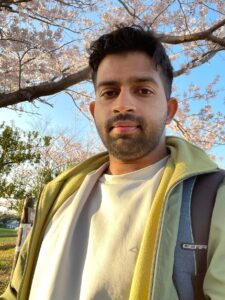
Name: Phil From: Philippines Area: Osaka
Occupation in Japan: TITP In Japan: 3 years (2017-2020)
Where did you study NIHONGO? I learned NIHONGO at a training center in the Philippines for a year. Even after going to Japan, I kept learning by watching ANIME and MANGA before work and during lunch break or by chatting with Japanese people at IZAKAYA. After coming back from Japan, I am now a Japanese-language teacher.
What kind of job did you do in Japan? I worked at a company of plastic molding as a trainee.
How was your life in Japan? It is difficult to talk about the hard times because I only had good experiences.
Message to Nihongo learners in the Philippines: Especially for N5 & N4 level or JFT-Basic examinees, it is important to keep at it every day. Also, it is necessary to learn four foundational skills of the language: Reading, writing, speaking, and listening. Ganbatte kudasai!

Name: Vishal From: India
Area: Nagoya -> Hiroshima -> Oita
Occupation in Japan: Vehicle Engineer In Japan: 2 years
Where did you study NIHONGO? I learned NIHONGO at a language school in India for half year.
How much NIHONGO do you need for your work? When I started working in Japan, I mostly used English for speaking and writing reports, but now I speak only Japanese with my colleagues and write reports only in Japanese. My Japanese has made a big progress after moving to Oita. That made my teacher surprised a lot.
Message to Nihongo learners in the Philippines: While you study Japanese, you must imagine that you are in Japan. At first, you should think about what you need to know and understand, and then start learning. Keep in mind, “I need to go to Japan!”

Name: Thuy From: Vietnam Area: Tokyo -> Hiroshima
Occupation: Office worker In Japan: 6 years + α
Where did you study NIHONGO? I learned NIHONGO in university in Vietnam. And now I study International Economic Development at a graduate school in Japan, while raising my child.
How much NIHONGO do you need for your work? I needed to write reports in Japanese, while I had some occasions to speak English and Vietnamese. However, it’s not necessary to learn advanced Japanese to communicate with Japanese people in your daily life.
Message to Nihongo learners in the Philippines: I started learning Japanese in Vietnam because I wanted to read Manga. It was very difficult for the first three years, but in the fourth year of university, I could make friends with Japanese students. That changed my life. Please make an opportunity to talk with Japanese people even if you are outside Japan.

Name: Alice From: France Area: Kobe -> Hiroshima
Occupation: Engineer In Japan: 2 years
Where did you study NIHONGO? After I took some NIHONGO classes at the university in France, I studied at the university in Kobe, Japan. And finally my dream to work in Japan came true!
How much NIHONGO do you need for your work? I speak English in my office, but I need to speak Japanese when I have meetings with clients. I think Japanese people can speak English, but they don’t want to. So, you need to speak Nihongo to communicate with them. The word I often use in the office is “Otsukaresama”.
Message to Nihongo learners in the Philippines: You might think it is easy to make progress from N5 to N4 level, while it is difficult and takes much time to achieve the N3 or upper level. I know how you feel. Hang in there and don’t stop learning!
